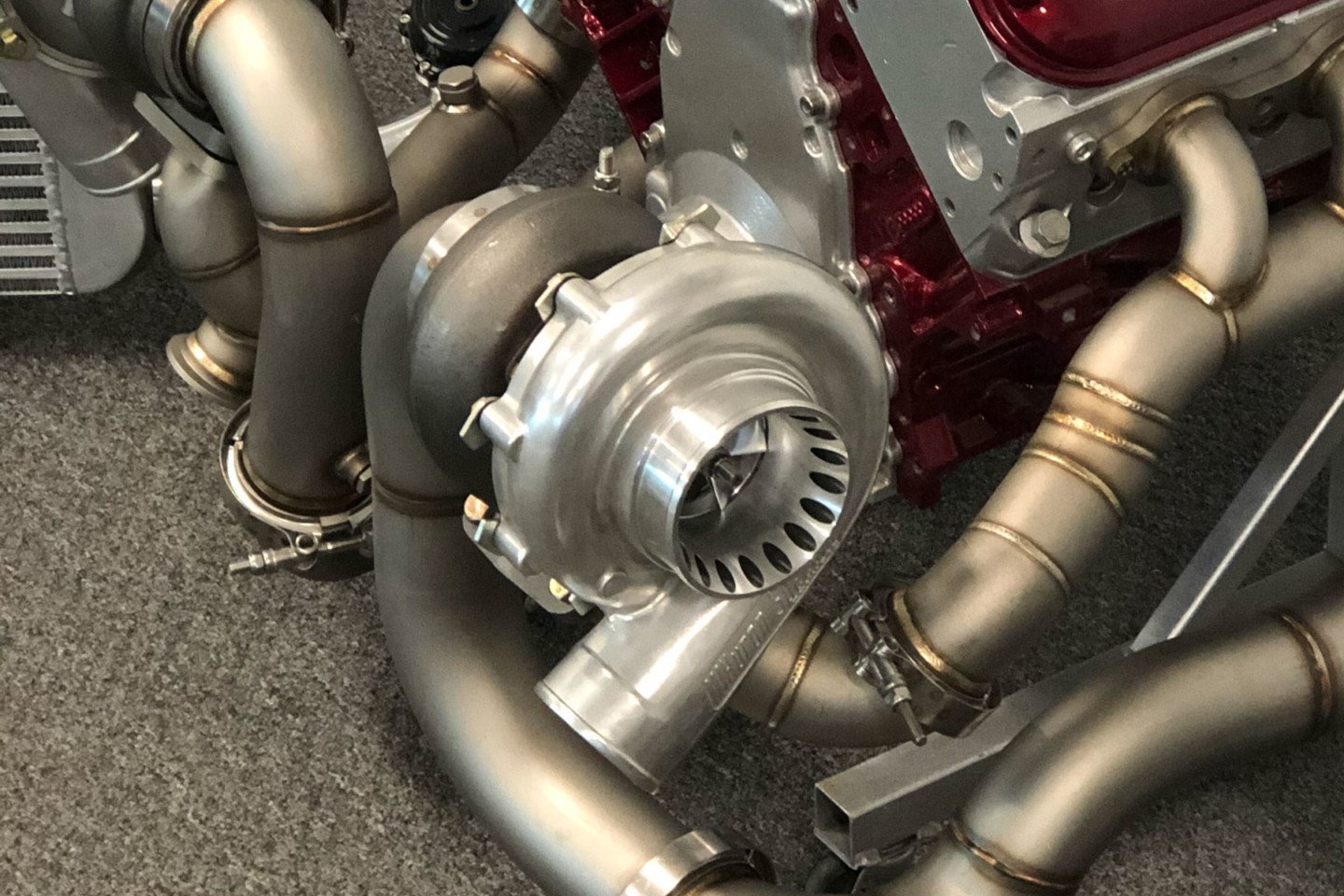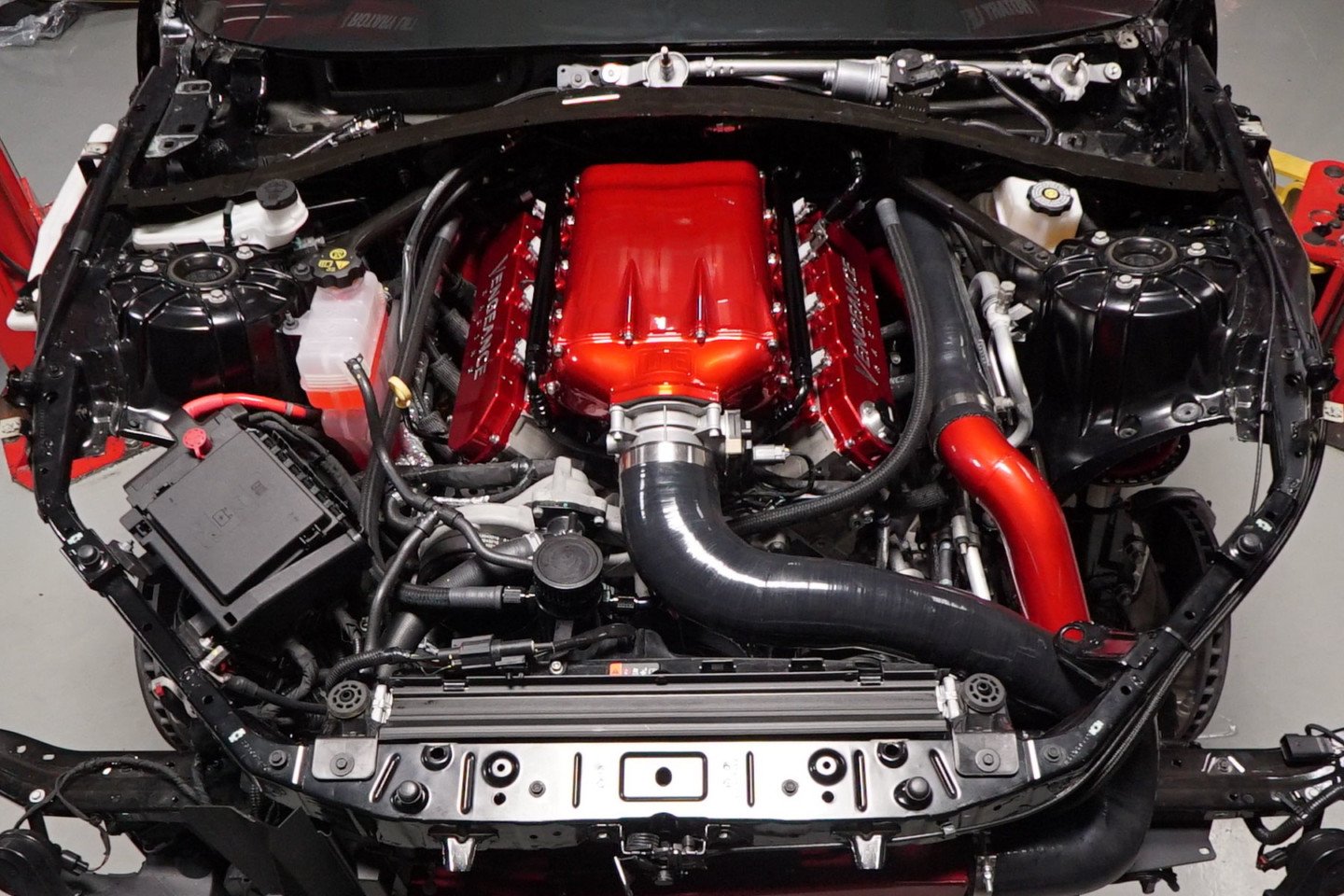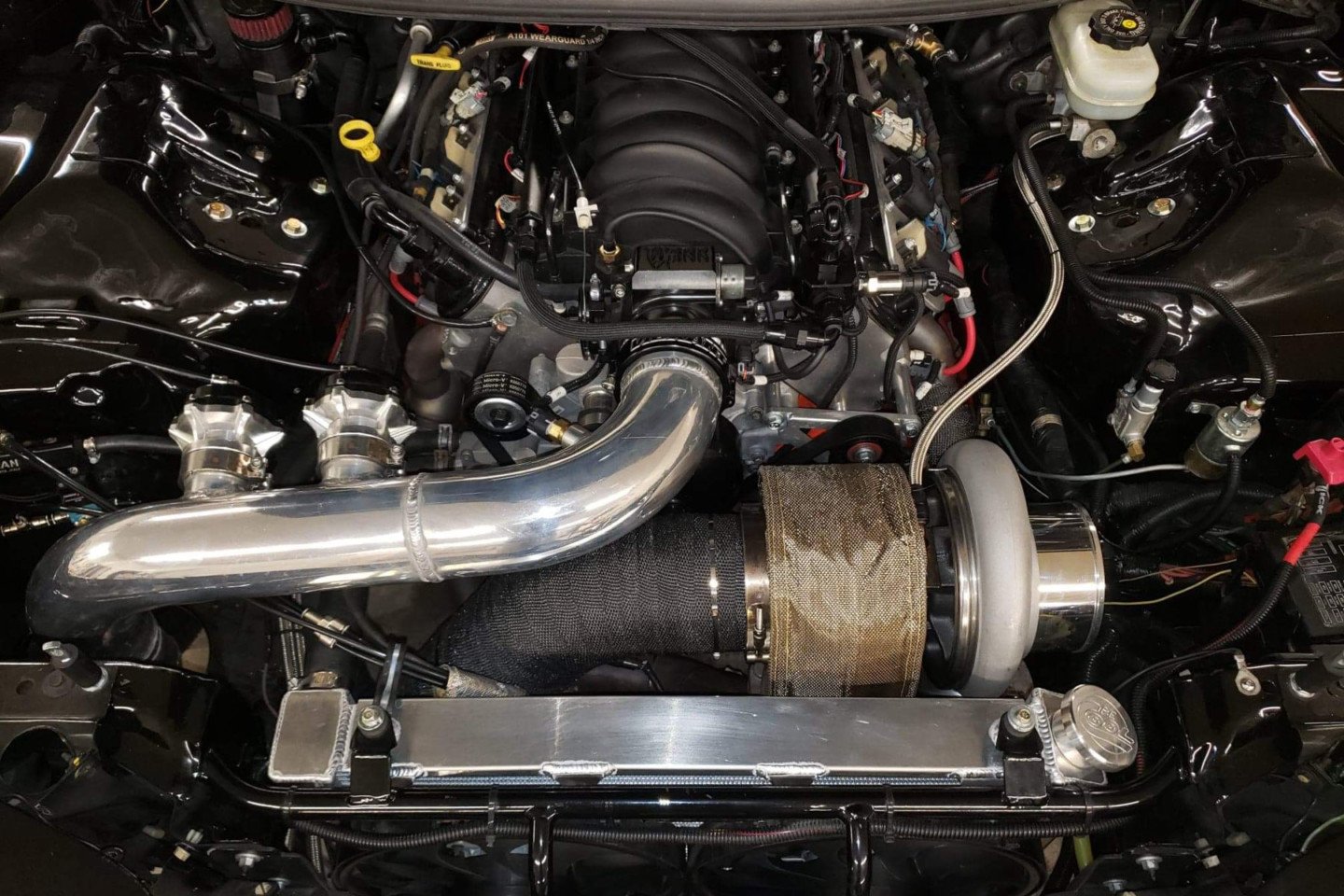Can Yo Put A Turbo On A Stock 6.0 Chevy And It Still Live
Allow's face up information technology, leaving a vehicle stock really isn't that fun, and adding horsepower just makes everything better. To feed your appetite for extra ponies, a power-adder of some kind is a necessity, and in the LS world that usually involves a turbocharger. In this article, we'll swoop into strategizing an LS engine build for adding some boost.
Despite what the internet volition tell you, you can't but bolt a turbo up to an LS engine and make monstrous horsepower…at least not effectively or with whatever sort of longevity. It takes the right supporting modifications and parts for that to happen. We're not going to put a heavy focus on the supporting mods in this article, instead, nosotros're going to focus on how to size a turbo, and what work is needed to an LS engine for this apply. To assist provide the all-time information possible, we brought in Jonathan Ojczyk from Huron Speed, along with engine builders Jimmy Stray, Darren Smithers, and Shawn Hooper at the School of Automotive Machinists & Applied science. This panel of experts has plenty of experience and knowledge to provide as it pertains to turbocharging an LS.
Information technology doesn't thing how many turbos you're using, they have to be sized correctly if y'all want to brand good horsepower.
Sizing A Turbo
The starting time step in any successful project is laying out a roadmap so yous have a programme to become to your final destination. When you're devising with a gameplan for your LS turbo project, knowing what your ability goals are, and being realistic nigh them is the most important step. This doesn't mean selecting the biggest turbo you can find and edifice around it, you lot need to look at the entire picture earlier you lot buy annihilation.
To kicking things off, you'll want to factor into the equation the size of the engine yous're going to employ, the parts in the engine, and what the balance of the driveline is going to look similar. Ojczyk explains why all of this information is so of import when y'all're selecting a turbo.
"Based off what a customer wants to do and how they plan to practice it, we tin can get them into a setup that volition not only make the power they're shooting for, but too do our best to ensure it spools well with the engine setup and also caters to their utilise of the vehicle. For example, we will spec something different for a track automobile with a transbrake and two-step, as opposed to a street motorcar that has a manual manual used only occasionally at the runway, even when their power goals are similar."
We typically don't become any smaller than a 75mm turbine wheel setup on any LS platform for efficiency reasons. – Jonathan Ojczyk, Huron Speed
How the vehicle will be used is very of import to continue in listen when you're shopping for a turbo. You can very easily get too large — sure you're going to brand a lot of ability on the dyno, merely the ability curve could be wrong for how yous're using the vehicle. What that means is your monster-sized snail isn't making real power until later in the RPM range and feels very sluggish down low. You lot can also be too conservative with the size of your turbo and the power will fall off dramatically equally the exhaust volume chokes when the engine is revved up.

Bigger isn't always improve when it comes to turbos. If yous tin't spool the turbo upwardly or information technology doesn't make ability downwards depression is it really whatever skillful?
When choosing a turbo for your combination efficiency is central. With an LS-based engine, the range of turbos you take to cull from is going to exist different than other engines based on how the mill functions.
"We typically don't get any smaller than a 75mm turbine wheel setup on any LS platform for efficiency reasons. Nosotros can get them to spool apace even on a 4.8-liter engine, simply any smaller will simply restrict the turbo system from making power. From there, we commonly go up to the T6 S400 chassis for single-turbo applications. For nigh street applications and engines in the four.8-6.0-liter size range, the 7675-7875 turbos work very well. Their size creates a packet that allows the machine or truck to retain every bit many accessories equally possible upwardly to the 750-850 rear bike horsepower zone," Ojczyk says.
Fortifying The Engine For Heave
The LS platform is highly touted for being boost-friendly, even in stock grade…it's nearly like the GM engineers wanted the engine to be a forced induction powerhouse. This boost-friendly framework and availability of the LS engine has made it one of the most popular engines to employ for high-operation applications of all kinds. Drag racers in particular love the engines considering of the great horsepower to budget ratio they provide.
GM stuffed LS-based engines into virtually every truck, van, and SUV chassis they could, which ways in that location are tons of these engines still bachelor today. SAM Tech'south Hooper shares what you tin look from the dissimilar engines when boosting them in stock form.
"All of the engines are groovy with a turbo, just the v.3 and half dozen.0-liter engines are the most popular. The 5.3 is the cheapest and easiest to detect, and so you'll see a lot of people use information technology. With a 5.iii and 6.0, you can see upwardly to one,000 horsepower on a stock motor if you push them. There are some who take made more, merely the gaskets and internal parts are going to struggle past that level to survive."
The rotating associates should ideally be rated for higher horsepower and RPM levels than you plan on running. -Daren Smithers, SAM Tech.
Yes, you can brand big power by throwing boost at a stock LS engine, however, if yous want the horsepower party to last for a long time you'll demand to make some changes to the engine. The stock components merely can't deal with the stress that forced induction can put on them when you really start to crank up the boost.
If you plan on running big heave you'd better brand sure your engine is set for it.
"The main deficiencies with a stock engine are the OEM parts just aren't designed for the loads of forced induction. Only the bottom end along with the rods, pistons, pins, ring gaps, piston-to-wall clearance, oil pump, and inconsistent bearing clearances that are designed for daily driving simply aren't rigid enough for sustained abuse…non to mention the potential valvetrain issues heavy heave could bring. Because of higher combustion temperatures and factory tolerances, it'southward literally luck of the draw in how long the engine will stay together when using stock components in an aftermarket boosted application," Stray explains.
So, allow's say you want to take your build beyond what the stock components are capable of surviving — where should you beginning making changes?
A lesser-upwardly approach is the best way to attack the build — the engine is going to need a solid foundation if you lot plan on throwing a lot of heave at it. After that, you want to offset looking at other things that could restrict the engine's ability to breathe.
"The rotating associates should ideally exist rated for higher horsepower and RPM levels than yous plan on running. All force per unit area is a resistance to flow. A loftier-flowing induction system will take less restriction, which results in lower boost levels of a more restrictive consecration combination at comparable horsepower levels. Cylinder heads bear upon naturally-aspirated volumetric efficiency, which does affect the pressure level ratio, and therefore compressor option of the turbo," Smithers says.

An engine with the right internal components volition handle large boost and horsepower with ease.
Calculation more detail to this point, Stray explains why information technology'due south important to build a stout rotating assembly when you're playing with high levels of heave.
"Because these engines will oftentimes run across higher RPM levels, if information technology's in the budget a center counter-weighted crankshaft is a wise investment. The connecting rods must be capable of withstanding the extra loads associated with boost, likewise. Choosing the correct wrist pin is vital, we want the lightest pivot that will easily withstand higher RPM without flexing, and of form, the correct piston and ring combination is important with a boosted LS application."

If you want to avert issues it's all-time to program your turbo LS build from start to finish.
When it'southward time to order the custom parts for a turbo LS awarding, all of your build data needs to be relayed to your engine architect and allow them make the telephone call on what you lot need to use.
"With elevated levels of rut, parts will aggrandize more; loose is better than too tight, and a wise man once told me if information technology's also tight everyone will know…as well loose, only yous will know. Following that advice, exist sure the piston manufacturer knows the level of boost you lot plan on running now, and when you turn it upwardly, then they tin can recommend the correct piston and clearance. Band gap is often overlooked — be realistic with your goals if you programme on turning information technology up because y'all'll need to gap the rings based on the added boost. It will relieve yous time and money down the road," Stray explains.
Putting your budget to work in the right places is going to requite you the biggest and best hazard for an engine that volition make lots of reliable power. Aftermarket cylinder heads are another surface area you lot might want to spend good money when you lot're trying to attain for the highest horsepower goals possible. A prepare of heads with a thick deck are where it's at…they will assist make sure the head gaskets stay exactly where they need to exist. Yous'll also want to make sure the valvetrain is up to dealing with elevated heave levels since in that location will be more stress put on all of the parts. Another affair you tin't overlook is the fuel system—a boosted application requires a lot of fuel, and underserving it volition lead to disaster.
Using the right turbo for your combination will make for a vehicle that's a smash to bulldoze and volition provide plenty of reliable horsepower.
"Another vital component is the oil pump—billet gears with a high pressure and volume option are a smart move depending on the requirements of the turbo(s)," Stray says of how to equip your LS engine when you're pushing the limits with boost. "A performance timing set attached to a camshaft with an LSA designed for heave should also be used. Some of the modifications to the top end would be performance roller lifters, rigid pushrods, and rocker artillery with springs capable of controlling the valvetrain at higher RPM. A good quality frazzle valve is besides a necessity for longevity…the increased heat is brutal."
Adding boost to an LS engine is like shooting fish in a barrel, merely doing it the right way is a little more than of a challenge. There'southward more to information technology than merely grabbing a turbo and welding some piping together. By doing some enquiry and setting realistic goals you can build a potent combination with a manufactory-stock engine, and selecting the right parts will allow you lot to build an engine capable of making big horsepower reliably.
Source: https://www.dragzine.com/tech-stories/turbo-fun-boost-basics-for-the-ls-based-engine-platform/
Posted by: suarezmighte.blogspot.com


0 Response to "Can Yo Put A Turbo On A Stock 6.0 Chevy And It Still Live"
Post a Comment